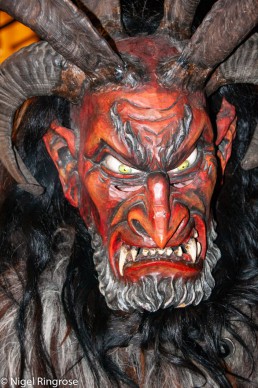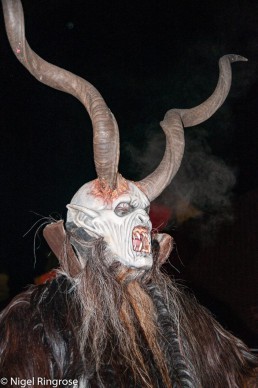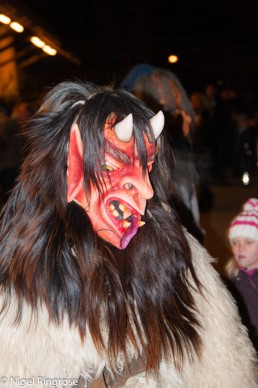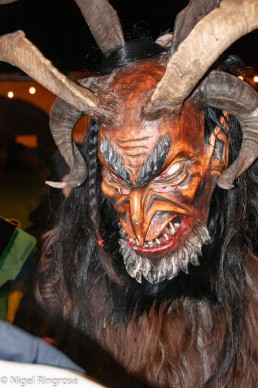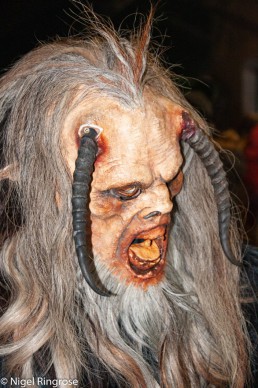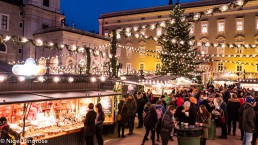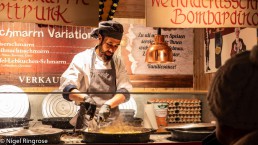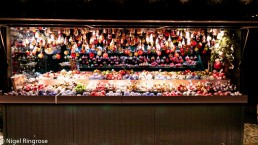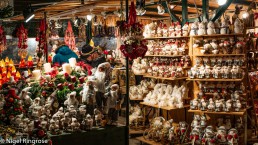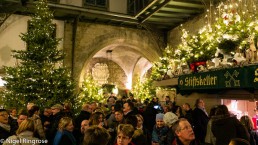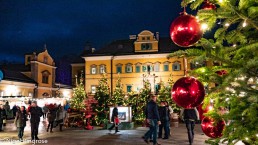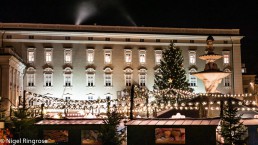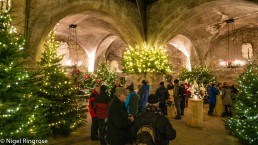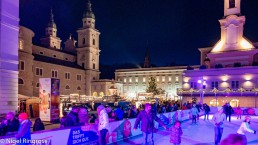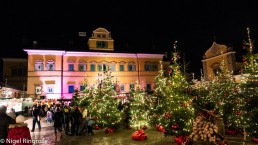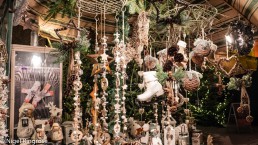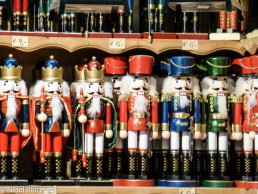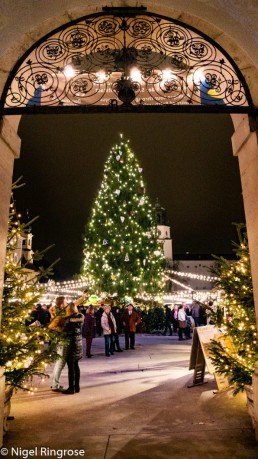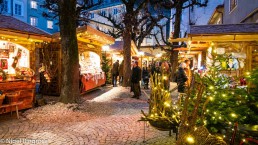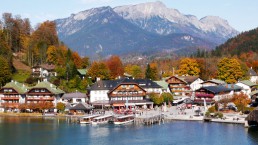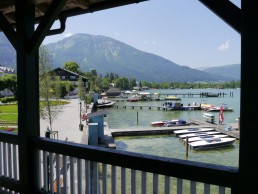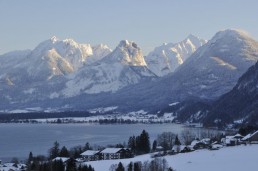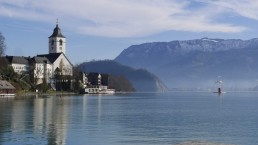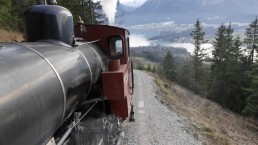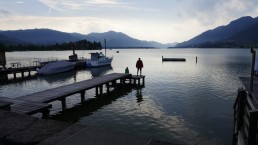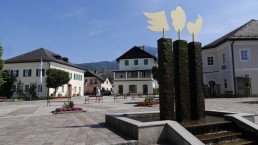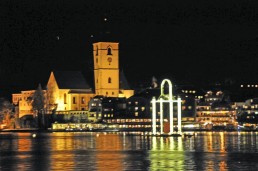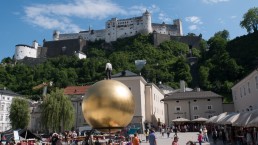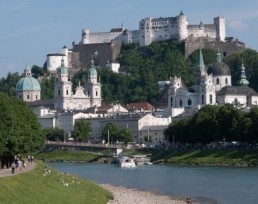Salzburg: The Krampus
If you are in Austria during December you may very well encounter the Krampus. These are half goat half demon creatures from Austrian folklore.
Legend has it that they accompanied St Nicholas on 6th December and, whereas St Nicholas rewarded the good children, the Krampus punished children who had misbehaved during the year. They would roam the streets with big bells around their waists and carry birch twigs to whip the naughty children. If a child had been really bad they would drag them down into the underworld, never to be seen again!
These days these creatures are ordinary people dressed in fantastic costumes with amazingly carved heads representing the demons. The main time to see them is the Krampuslauf (the Krampus Run) which is held in towns and villages around the 6th December. In the big cities there can be over a hundred Krampus on the run.
Accompanying the Krampus is St Nicholas and also people dressed as Perchten, angels and old women. So its not all bad!
Perchten are creatures from ancient Austrian folklore that drive out the demons and bad spirits of Winter. They usually appear around the Winter Solstice and early January must can make an appearance with the Krampus on their Krampuslauf.
Salzburg Christmas Markets
The Christmas Markets in Salzburg are truly magical. Especially if you are lucky enough to have snow during your visit.
They run from the end of November (21st in 2019) to December 26th. Opening times vary but they are usually open from 10:00 to 20:30. If you are from outside of continental Europe you may have experienced so called “German Markets”, but they cannot compare to the real thing. Everything is of a high quality and tasteful, not a Santa in sight!
Where to Find Them
In Salzburg there are 3 main Christmas Markets:-
• The main market is around the Dom in Residenzplatz and Domplatz and is dominated by a huge Christmas Tree
• A smaller, but equally nice market is in the squares around Sternbrau
• Finally there is a small market in the precincts of the Fortress
There are other markets but these are the main ones that are worth a visit, especially if you are a little short of time.
So what makes these Christmas Markets special? Well, apart from being in the wonderful City of Salzburg and the fantastic festive atmosphere, they sell a variety of goods together with traditional Austrian food and drink to keep you going.
What Can You Buy?
Broadly speaking the merchandise on offer is:-
• Christmas decorations, floral arrangements, candles, incense etc
• Clothes, gloves and scarves
• Crafts and toys – especially traditional wooden toys
• Jewellery, handbags etc
• Confectionery
• Food and drink (of course Gluhwein!)
If you are able, the best time to get there is around dusk as all the lights come on but if not, don’t worry you will not be disappointed. Be aware that at the weekend it can get pretty crowded but even then it is still convivial and good natured.
What’s On?
During the course of the markets there are special events with Advent singing on the steps of the Dom. In early December there is the famous Krampuslauf (the Krampus Run). The Krampus are traditional Austrian mythical creatures that are half goat and half demon. Whereas good children and rewarded by St Nicholas, children who have misbehaved during the year are punished by the Krampus. This is usually with small branches gently whipped around the legs. If this all sounds horrific, don’t worry; it is all good natured and the children absolutely love it (if not a little scared).
Further Afield
If you have time on your visit to Salzburg there is another Christmas Market that is absolutely wonderful. It is at Schloss Hellbrunn on the outskirts of the City and can be reached by car, Taxi or bus. It is held in the grounds of the Palace and is magical, but it can get really crowded, so much so they introduced an entrance fee of €5 per person during peak times in 2018. In addition to the Market, you can also walk around the grounds and the Italian garden.
Finally
One final thing to point out is to wrap up warm. In December it is usually very cold in Salzburg and the temperature drops dramatically after dark. Good shoes, warm clothing and a hat, scarf and gloves are essential.
Enjoy yourself and take in the atmosphere. The memories from the Salzburg Christmas Markets will make your Christmas and keep you going well into the New Year.
A Day Out in Bavaria
If you are looking for a day out during your stay in Salzburg then in less than an hour you could be in the Bavarian Alps. Visit the pretty alpine town of Berchesgarden and the magnificent Konigsee lake.
If you have access to a car then its an easy drive taking about 30 minutes. A regular bust service from Salzburg takes around 45 minutes.
By Bus:
There is a direct service outside of the main train station in Salzburg. The bus you need is the 840 and this will be clearly displayed on the front of the bus. Tickets are available both from the ticket machine at the bus station or you can buy them directly from the driver. The 840 bus starts off outside the Main station in Salzburg but you also catch it at Mirabellplatz, Rathaus, Mozartsteig and at the Justizgebaude. Once at Berchtesgaden it stops at the Salt Mine (“Salzbergwerk), Watzmann Therme, Schiesstattbrucke and the main train station. If you want to go into the centre of the town then get off at Schiesstattbrucke.
Tickets cost €5.80 for a single or you can buy a day ticket for €10. The timetable and more information is available here.
If you wanted to also visit the Salt Mines at Berchtestgaden as part of your day out, the bus stops right outside.
By Car:
Getting to Berchtestgaden by car is quite straightforward and although the road numbers change it is essentially the same road all the way. If you have sat nav available then the destination is simply Berchtesgaden.
If you are starting from within the city then head for Alpenstrasse (road number 150). This starts at the Karolinen Brucke, one of the main bridges over the Salzach River. Stay on this road travelling south passing by Anif and over the Autobahn. Follow the signs for Berchtesgaden. Note that at the Autobahn the road number changes to 160 and then at the Austria-German border it becomes the 305. There is no border control any more so you can go straight into Germany but make sure you have your passport available just in case there is a traffic check.
Once in Berchtesgarden, look out for road on the left just past the Salt Mine that is signposted to Obersalzberg and the Kehlsteinhaus. Turn right at this junction and take the road up into the town. Opposite the Edelweiss hotel is the entrance to the underground car park.
Points along the way
On the way to Bertchesgaden you will pass through St Leonhard, a small village at the foot of the Untersberg mountain. Incidently, this is where you can get the cable car to the summit, well worth a trip but be careful in winter.
Soon after crossing the border you go through the pretty village of Marktschellenberg and into the mountains. After 20 minutes will have your first view of the Watzmann mountain with its twin peaks. On the outskirts of Bertchesgaden on your left you will see the Salt Mines, and shortly after on your left is the road up the Eagles Nest (Kehlsteinhaus). The small building is in fact an old SS Guard Post.
In Bertchesgaden
The town itself nestles in the Bavarian Alps and is dominated by the mighty Watzmann mountain. The centre of the town is compact and pedestrianised so just wander around and take it all in. You will see that many of the houses are decorated with traditional Bavarian frescos called “Luftmalerei”.
There is an assortment of shops where you can find wood carvings and Bavarian clothes. The town has many cafes and restaurants serving everything from coffee and cakes to traditional Bavarian dishes and beer. A great place to eat is the roof terrace of the Hotel Eidelweiss with stunning views of the town and mountains.
Through the archway from the Markt is the Schlossplatz. This open area is bordered on two sides by the residence of the former rulers of the Bertchesgadener Land and the main 12th century church. Both the church and the Residence (“Schloss”) are open to the public. Opposite the church is an arcade painted with murals of the men of the Bertchesgardener Land going off to war.
Konigsee Lake
If you have time then a visit to the nearby lake of Konigsee is well worth it. There is a bus that leaves from the main train station (“Hauptbarnoff”) in Bertchesgaden that will take you directly to the lake.
If you have a car then follow the signs to Konigsee from the large roundabout outside the train station. It takes about 10 minutes and there is a large pay and display carpark.
A Day Out in the Salzkammergut
If you are looking for a day trip from Salzburg to spectacular lakes and mountains then the Salzkammergut is for you. The Salzkammergut region covers a large area of lakes and mountains but for our day out we are going to concentrate on one of the most popular lakes, Wolgangsee. It is also the easiest to get to from Salzburg and offers a wide range of attractions and sights.
Getting There
If you have access to a car it is a straightforward drive to the main lake Wolfgangsee. If you don't have a car, do not depair, there is a regular bus service from Salzburg to St Gilgen. From here you can get a ferry that does a circuit of the lake calling at St Wolfgang and Strobl amongst others. You can leave at any point, have a look around and then hop back on a later boat.
By car
Head for Route 158 (Wolfgangsee Strasse) to the east of the city and keep on this road all the way. If you have a sat nav enter St Gilgen. Along this route you will pass the pretty lake and town of Fuschl to your left. Keep an eye out for a modern building on the right with bronze bulls stampeding out of the offfices. This was until recently the headquarters of Red Bull! As you near St Gilgen you will see a small carpark on your right, its easily missed but it has a fantastic vista of the lake. mountains and the town of St Gilgen. The large mountain to your left is the Schaffberg that has a cog railway all the way to the summit.
Descending into St Gilgen you will see signs for many carparks. In the peak season expect to park a little further out rather than in the centre.
By Bus
Bus 150 leaves the main train station every 30 minutes. You can also catch the same bus at Mirabelplatz. The cost is €13.80 return and takes about 50 minutes. The bus stops at the bus station in St Gilgen and then it is a short walk into the town and the lake. For information about any bus service in and around Salzburg go to https://fahrplan.salzburg-verkehr.at/
St Gilgen
This elegent town is at the north west of Wolfgansee lake and is one of the main departure points for the frequent ferries around the lake. A round trip takes about 2 hours but you can stop at the wonderful St Wolfgang and the little town of Strobl along the way. The ferries operate from Mid April until the end of October. During Advent they do special cruises to visit the Christmas Market. Each ferry has a little bar serving hot and cold drinks and snacks.
Ticket prices for 2019 for a round trip are €21.20 for adults and €10.70 for children. This is for a single entry and exit per stop. If you just want to go to St Wolfgang then these tickets are a bit cheaper.
Also in the town is the cable car up to the mountain behind St Gilgen called the Zwolferhorn. From the top there are wonderful views of the lake and surrounding mountains. It is open all year except from early January to early February. Cost for a round trip is €24.50 for adults and €15.00 for children.
There is a strong connection with Mozart in St Gilgen although Mozart himself never got to go there. His grandfather worked in the town, his mother was born in St. Gilgen, and his sister Nannerl moved there after her marriage. There is a small museum in the town.
St Wolfgang
St Wolfgang is the jewel of Wolfgangsee nestling at the foot of the mighty Schafberg mountain. The name is derived from Saint Wolfgang who founded the first church here in 976. The church became a place of pilgrimage and the current church dates from the 14th century. From the terrace behind the church you get a lovely view of the lake and mountains. If you have a car you can drive to St Wolfgang but personally it is easier to take the ferry and enjoy the views.
The town is also famous for the White Horse Inn featured in the operetta by Ralph Benatzky and the film. It sits on the water's edge and still attract guests from all over the world.
Just outside the town is the cog railway that takes you to the summit of the Schafberg mountain in about 35 minutes. This little train jugs up the mountain for nearly 6km before reaching the top at 1783m. The views along the way and at the summit are fabulous. You really feel as if you are on top of the world. Perched on the very top and at the edge of a precipitous cliff is the Hotel Schafsbergspitze, the oldest mountain inn in Austria dating from 1862. The railway is open from Mid May to the end of October. Note that in 2019 it will only go half way in October due to construction work.
The cost is €39.60 for adults and €19.80 for children. Trains start at 08:55 with the last train down at 17:05
Strobl
Strobl is a small town at the far end of Wolfgangsee and is a lot calmer than the busy St Wolfgang. Although dating from the medieval period, Strobl became increasingly important as a holiday resort once the Hapsberg family built their summer palace at nearby Bad Ischl.
It has a pretty promenade where you can go water skiing or hire a boat or just relax. It also has a flat lakeshore and natural beaches where you can swim.
If you have a full day in Salzburg ...
If you only have a day in Salzburg what should you do to make the most of your time? Well obviously it depends on you and your preferences but here we will pick out some of the best choices so you can take your pick!
Getting to the Old Town
No matter how you arrived in this wonderful city, make for the Old Town (Altstadt). Salzburg is well served with bus routes and it is relatively easy to get to the centre of the action:-
From the airport - get the Stadtbus number 27. The stop you want is Ferdinand-Hanusch-Platz right in the Old Town next to the River Salzach. Keep an eye on the information screen in the bus to see where you are and the next stop. Cost is €2.
From the Main Train Station - get the Obus number 3 and get off at the Rathaus. The information screen in the bus will tell you the stops. This is also right in the Old Town next to the River Salzach. Cost is €2.
If you are arriving by car there are many carparks in and around the city. Be aware that carparks in Salzburg can be expensive if you park in the centre. There are 4 park and ride sites around the city where you can park the car and get discounted bus fares into the city.
Salzburg Card
If you plan to go round some of the museums and up to the Fortress, the 24 hour Salzburgcard will save you a lot of money. It costs €29 for adults and €14.50 for children 6-15 during May to October. At other times it is €26 for adults and €13 for children 6-15 .
The card gives you free access to:-
- Mozarts Birth Place
- Dom Quartier museums
- The Fortress Funicular and Museum
- The Catacombs
- The Monchberg Lift
- Mozarts Residence
You can buy it online before you go or buy it on the day from hotels, ticket offices and tourist information centres. If you buy online you will receive a voucher that you need to exchange at the Tourist Information Centre in Mozartplatz.
Making a Start
The centre of Salzburg is quite compact and pedestrianised so it is easy to get around. I am assuming that your a starting your tour from the river, it is easy to adapt if you are coming in from another direction.
On the main road that borders the River Salzach you need to head to one of the entrances to the Old Town, these are between or under the buildings fronting the river. From the bus stop at Hanusch-Platz, cross the road at the crossing and make your way towards the main bridge over the river. Just before this you will see an arched passage on your right called Hagenaueplatz. Go through here and immediately in front of you you will see the yellow building that is Mozart's Birthplace (Geburtshaus). If you have got off the bus at the Rathaus, walk through the passage and then turn right. You will see the Geburtshaus on your right in about 100m.
Mozarts Geburtshaus
Wolfgang Amadeus Mozart was born at number 9 Getreidegasse on 27th January 1756. Their apartment was on the 3rd floor and is now one of the most visited museums in the world.
The Mozart family lived in the house from 1747 to 1773. They then moved across the river to what is now known as the Mozart Residence (Wohnhaus) in Makartplatz. Mozart spent his childhood and much of his youth here together with his father Leopold, Mother Anna Maria and his sister ‘Nannerl’.
The house itself was built in the 12th century and was owned by the Hagenauer family. The museum occupies the second and third floors and introduces visitors to Mozart’s early life. The exhibits include his first musical instruments together with portraits, documents and early additions of his work. On the second floor you will find the clavichord on which he composed The Magic Flute.
Opening Times: Daily 09:00 to 17:30. In July and August it is open until 19:00 (Last entry 30 mins before closing)
Cost: € 11,- (€ 18,-) for adults. Young Adults (15-18 years) € 4,- (€ 6,-). Children (6-14 years) € 3,50 (€ 5,-) . Prices in brackets are a combined ticket for both the Birthplace and Wohnhaus.
More Information: http://www.mozarteum.at/en/museums/
When leaving the Geburthaus turn right and continue along the main shopping street. In about 400m you will come to Mozartplatz.
Mozartplatz
In the centre of Mozartplatz is the imposing statue of Mozart. This was finished in 1842 and was unveiled in the presence of Mozart’s two sons, Karl and Xavier. Mozart’s wife, Constanza, lived in Mozartplatz at number 8 but although she saw the monument being built she died before the unveiling. From the statue you will see the next square, Residenzplatz.
Residenzplatz
The square is dominated by the Cathedral and the Residenz Palace to its right. Opposite the Residenz is the Salzburg Museum with its Carrilon tower. If you fancy a coffee at this point then MozArts cafe underneath the carrilon is recommended. In the centre of the square is the famous Horse Fountain dating from 1661. From Residenzplatz you can visit the World Heritage Site of the Dom Quartier.
Dom Quartier
If you are interested in history and culture then a tour of the Dom Quartier of Salzburg is a must. It includes the State Rooms of the Residenz Palace, the Cathedral Museum and the Monastic Museum of St Peters Abbey. In all there are over 2000 exhibits covering 1300 years of Salzburg History.
Opening Times: Daily during July and August. At other times of the year it is closed on Tuesdays. 10:00 to 17:00 (18:00 in July and August)
Cost: Adults €13, Children over 6 €5 Children under 6 are free
Leaving the precinct of the Dom Quartier entrance, turn right through arches to the cathedral.
Salzburg Cathedral
The cathedral is impressive inside with ornate decorations and chapels. In the crypt you can see the foundations of previous buildings and parts of Roman mosaics found during excavations. Inside you can also see the font in which Mozart was baptised.
The baroque façade of the Dom has four large scuplted figures of the saints. Facing the cathedral is Domplatz, an enclosed square that contains the impressive column of Maria Immaculata.
Coming out of the cathedral turn left and through arches into the magnificent Kapitalplatz.
Kapitalplatz
The first thing you will see, apart from the Fortress, is a large golden sphere with a man on top. This is famous work of art by Stephan Balkenhol called Sphaera.
Dominating the square is the Hohen Salzburg, one of the best preserved medieval castles in Europe. On the other side of the square in the Chapter Fountain dating from 1732, a horse pond used for washing horses. at the far corner of the square is a small road that takes you to the Funicular Railway that takes you up to the Fortress.
The Fortress
A visit to the fortress is a must and will transport you into a different world. The existing fortress dates from the 15th century with later additions in the 17th century. It consists of various wings and courtyards and in addition to the state rooms of the Archbishops. You can also visit the Puppet Museum and see the Salzburg Bull. This is a large aerophon of more than 200 pipes that was built in 1502 and still played every day.
At the front of the fortress you will have magnificent views over the city. At the rear you can see down the Salzach valley right down to the mountains at the Salzach Gap. You will have a grandstand view of Salzburg’s own mountain, the Untersberg, which rises to over 6,000 ft.
Opening Times: Daily January to April and October to December 09:30 to 17:00, May to September 09:00 to 19:00.
Cost: €15.50 which includes the cost of the funicular up to the castle
On returning from the Fortress, walk back down to Kapitalplatz but turn left immediately you enter the square. Go between the gap in the buildings in the corner and you come to the old bakery complete with water wheel. Opposite the bakery is the gate through to the cemetery and catacombs.
St Peter's Cemetery
This such a beautiful and peaceful place in the centre of the town. It is the monastic cemetery of St Peter's Monestary and is characterised by arcades of eleborate tombs including Johann Haydn and Mozart's sister, Nannerl. Set into the rock face are the catacombs. Carved out of the solid rock these were probably constructed between 300 and 600AD by early christians.
Cemetery Opening Times: April to September: 06:30 to 20:00, October to March: 06:30 to 18:00
Catacombs Opening Times: May to September: 10:00 to 12:30 and 13:00 to 18:00. October to April: 10:00 to 12:30 and 13:00 to 17:00
Catacombs Cost: €2
Leave the cemetary through the arch underneath the Monestary in the opposite corner to where you entered. This brings you to St Peter's Church.
St Peter's Church
Coming through the arch from the cemetery you will see Stiftskeller St Peter on your left which has been serving food since 803! It is claimed to be the oldest restaurant in Europe. It is here that they hold the celebrated Mozart Dinner Concerts where musicians in period dress serenade you whilst you dine. St Peters is a Benedictine monastery and was a former cathedral. It is considered to be one of the oldest monasteries in the German speaking countries. It has been in continuous use since its foundation in 696. The present day abbey church is in the Romanesque style and was erected in the 12th century.
Leave the square through the arch opposite the church and then though the next arch into a small square. Exit the square and turn left and you will see the Haus Fur Mozart.
Haus Fur Mozart
These are the concert halls, the main venue for the famous Salzburg Festival in August each year. Inside there is the Rock Riding School with its impressive 96 arcade spaces. Although not visible from the road it can be visited each day at 2pm. Tickets from the Box Office.
Opposite the Haus Fur Mozart is the Collegiate Church.
Follow the road outside the Haus Fur Mozart until you come to the Horse Fountain.
Horse Fountain
At the end of the road you will see the Horse Fountain. This is where the horses from the Prince Archbishop's stables were washed and dates from the 17th Century.
Carry on along the road for 200 metres and you will come to the Monschberg Lift.
Monschberg Lift
Go inside the tunnel to the lift that will take you up to the terrace in front of the Museum Der Moderne for the best view of Salzburg. It only takes a few minutes but boy is it worth. If you want you can either visit the museum or come back down.
When you exit the tunnel across the road there is a pedestrianised road called Griesgasse. Follow this back to Hanusch-Platz by the river.
Mozart's Residence
At the river, cross over using the footbridge festooned with lover's padlocks. When you reach the road, cross over and make your way into the square. On the right, the pink building is Mozart' Residence. The Mozart family moved to the house on Makartplatz in 1773 and stayed there until 1787. The museum opened in 1996 and in addition to Mozart’s forte-piano contains many original documents and portraits.
Opening Times: Daily from 09:00 to 17:30 and in July and August from 08:30 to 19:00. Note that during Mozart week the museum may be closed for concerts.
Cost: € 11 (€ 18) for adults. Young Adults (15-18 years) € 4 (€ 6). Children (6-14 years) € 3,50 (€ 5) . Prices in brackets are a combined ticket for both the Birthplace and Residence.
Opposite Mozart's Residence are the Mirabell Gardens.
Mirabell Gardens
The gardens date from 1687 and follow a geometric pattern containing mythology themed statues. The palace dates from 1606 and was built by Prince-Archbishop Wolf Dietrich Raitenau who wanted a pleasure palace for him and his mistress!
Opening Times: Mirabell Palace and Angel Staircase 08:00 to 18:00. Marble Hall 08:00 to 16:00 (13:00 to 16:00 on Tuesday and Friday).
Gardens are open from 06:00 to dusk.
That concludes your day sightseeing in Salzburg. I hope you found it of interest and enjoyed your day in this magical city.
If you only have a few hours ...
Maybe you only have a few hours in Salzburg and are unsure of what to see and do to make the most of your time. Well, here are my suggestions to ensure you capture the essence of this lovely city. Salzburg is quite large but the old town, Altstadt, is small and pedestrianised so it is relatively easy to get around. If you are tight for time then you probably won't have time to visit any museums or the Fortress so these have been omitted.
Getting to the Old Town
If you are coming into the city from the railway station, then your first stop should be the Mirabel Gardens. This is on the main bus route from the station into the old town. Catch either a number 1, 3, 5 or 6. All of the buses have a screen that shows you the next stop so look out for Mirabel. Either buy a ticket from one of the machines at the railway station, or you can pay the driver but this will cost a little more.
Mirabel
Mirabel Palace dates from 1606 and was built by Prince-Archbishop Wolf Dietrich Raitenau who wanted a pleasure palace for him and his mistress. Inside the palace is the Marble Hall used for both concerts and weddings, pop in and have a look if you have time. The gardens date from 1687 and follow a geometric pattern containing mythology themed statues and have a lovely view of the Fotress. If you are a fan of The Sound of Music then go to the left side of the Palace and you will recognise the Pegasus fountain and of course, the "Do-Re-Me" steps.
Mozart's Residence
Leave the gardens at the gateway facing the Fortress and out onto Makartplaz. Opposite you will see a pink building on the corner, this is where Mozart lived from 1773 to 1787. If you fancy a coffee, tea or a snack, then there is a nice cafe on the ground floor.
Turn right out of Mirabel Gardens past the theatre (Salzburger Landestheater) and cross the main road to the river. Here you will find the footbridge over the Salzach with magnificent views of the city dominated by the Fortress. On the other side of the bridge cross the two roads and on your right you will see the entrance to Sternbrau (it has a big star on top of the building). Go into the small square and then through one of the passages on the other side and you will find yourself in the main shopping street, Getreidegasse. It has both traditional and designer shops. By the way, Sternbrau has a number of restaurants and bars, and outside tables if you want to stop for lunch.
Mozart's Birthplace
Turning left from Sternbrau will take you past Mozart's birth place (Geburtshaus) and into the centre of the old town. A bit further on from here is Altermarkt, turn right into this square and up to the top. On your right you will see Cafe Tomaselli, the oldest coffee house in Austria where they say Mozart was a patron.
Residenzplatz / Cathedral
Turn left and on into Residenzplatz. Here is the famous Horse Fountain and Salzburg Cathedral. You will also see the Carillon tower and to the left, the square goes into Mozartplatz with the majestic statue of Mozart at its centre.
If you are facing the cathedral you will see on your right the palace of the Prince-Archbishops, the Residenz. Between the palace and the cathedral is the way through to the Cathedral Square, Domplatz. Here is the entrance to the cathedral with the 4 large statues of the saints. The cathedral is well worth a quick look as it is very ornate and has the font in which Mozart was baptised. In the centre of Domplatz is the impressive column of Maria Immaculata.
Kapitalplatz / The Fortress
From the cathedral go through the arches into Kapitalplatz where a magnificent view of the Fortress awaits. The golden sphere with a man on top is called "Sphaera" by Stephan Balkenhol. In the left corner is an ornate horsepond that was used to wash the horses.
Make your way to the gap between the buildings on the far right top corner of the square. Through here you will find the old bakery complete with waterwheel.
St Peter's Cemetery & Church
Opposite the bakery is the gate through to St Peter's Cemetery with tombs in arcades. There are also ancient catacombs cut into the rock.
Exit the cemetary through the tunnel to the left of the church. As you come into the square on the right is the oldest restaurant in Europe. They have been serving food since 803! The large church is the monestary chuch of St Peter which used to be the cathedral.
Haus Fur Mozart / Horsepond
If you go through the archways on the opposite side of the square to the church you will come out next to the Haus Fur Mozart, the main venue for the famous annual Salzburg Festival. Opposite the Haus Fur Mozart is the Collegiate Church. Follow the road past the concert halls and you will see the Horsepond on your left just over the road.
Monchberg Lift / View of Salzburg
Go past the horsepond for another 200 metres and you will see the entrance to the Monschberg Lift on the left. The lift costs €3.80 to go up and down but it is well worth it for the best view of Salzburg.
Coming out of the lift entrance, cross the road and follow the road back to the river.
